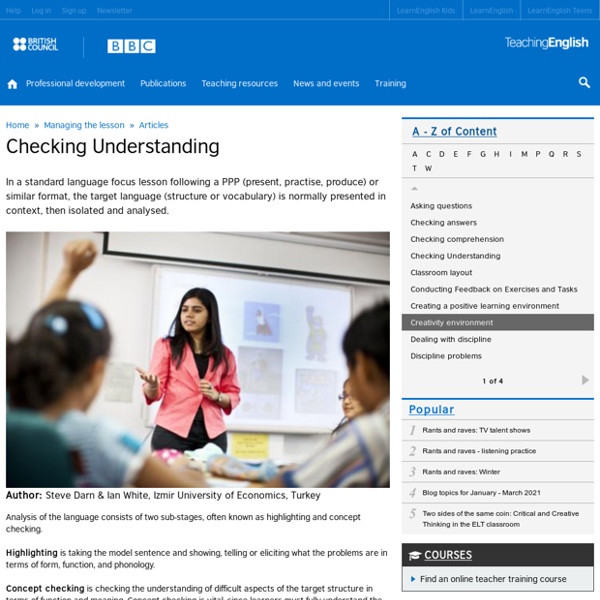Analysing Language
Checking understanding generally follows the isolation of new language which has been presented in context, analysed and fully explained. It is this analysis and explanation stage which is the focus here. A framework for analysis Form and phonology Function and meaning Register and appropriacy Post analysis A framework for analysis The teacher may present language inductively through a text, a situation, through a task, or simply asks learners to 'notice' lexis. Alternatively a deductive approach may be used whereby the learners are given the rules and asked to apply them in using the language. In either case the learners need to fully understand the language before they begin to practise it in guided activities, or produce it together with other 'known' language.
Nine ways to revise English vocabulary using slips of paper
What can teachers do when classroom technology stops working? Cristina Cabal, latest winner of the British Council's TeachingEnglish blog award for her post on pronunciation, suggests nine activities for revising English vocabulary using simple slips of paper. Nowadays, it seems very simple to plan a lesson that makes use of the many tools available online, especially as more and more of us have access to the Internet in our classrooms. But while technology is increasingly part of our teaching, there are times when it can cause problems and frustrations for teachers, such as when the Wi-Fi stops working or the computer shuts down, leaving you with a one-hour lesson to teach and no plan B up your sleeve. One of the best ways to deal with this situation is to use slips of paper – a resource available to every teacher in any given situation.
Using students' first languages in the classroom
Summary: Using students' first languages in the classroom Whether it is better to use the students' first language (L1) in class or have an English-only policy is something that has been much debated and that has seen many changes of fashion over the years. It seems, therefore, that the only sensible reaction an individual teacher can take to this controversial subject is to neither accept nor reject the use of L1, but simply to search for an ideal level of its use in each individual class- maybe changing its use as the class progresses in level or changes in other ways. Here are some tips to help you spot if you have found your own perfect level of L1 use in your classes and how to adjust the level if you haven't reached that point yet.
Kids and songs
On the LearnEnglish Kids website, you can find a wide range of both modern and traditional songs to use with your learners together with accompanying worksheets written by our young learner specialists and aimed specifically at children learning English as a second or foreign language. Why use songs in the primary classroom?Songs tend to be repetitive and have a strong rhythm. They are easily learnt by primary children and quickly become favourites because of their familiarity. They are fun and motivating for children. They allow language to be reinforced in a natural context, both with structures and vocabulary.
Developing pronunciation through songs
Songs provide examples of authentic, memorable and rhythmic language. They can be motivating for students keen to repeatedly listen to and imitate their musical heroes. Here, we look at some aspects of pronunciation that can be focused on through songs. Using songs to focus on soundsUsing songs to focus on wordsUsing songs to focus on connected speechConclusion Using songs to focus on sounds Sounds are the smallest unit from which words are formed and can be categorised as vowels and consonants. Why are they difficult?
Grouping students
Do you think about whether you’ve got a balance between pairs, groups, whole class and individual work? If you have activities for pairs and groups, do you let the students decide who they’re going to work with or do you decide? This tip looks at the advantages and disadvantages of the three main ways of grouping students. They are, giving students the choice, random grouping and selecting the groups yourself. You’ll probably find that no one way will always be the best choice for a particular group, but that you’ll use all three ways at different times depending on your students and the activities you plan to do.
Bloom's taxonomy and English language learners
Thinking Skills and English language learners English language learners should be asked critical thinking questions from all levels of Bloom's Taxonomy. Some of the tasks on the taxonomy are difficult for ELLs because they lack the language and vocabulary to work in English. However, teachers need to ask questions from all levels of the taxonomy that are age appropriate and at the English language level of the English language learners. Even very young children can work at the Synthesis and Evaluation levels.
Total physical response - TPR
Where is it from? How can I use it in class? When should I use it? Why should I use it in the classroom? A few useful variations Are there any disadvantages with using TPR?
Who needs resources?
What type of lessons would this include The following types of lessons would use minimal or no resources, and the students would have to produce most of it using their creative minds and using the teacher as a go-between. The only problem is whether or not you can maximise their potential. • Role plays – you can set the topic and area, but they write and perform them.
How to keep your students motivated
Cristina Cabal has been teaching for 26 years. She shares some of her top tips for keeping students motivated. How do you keep students motivated? I like to compare it to keeping a healthy successful marriage.



